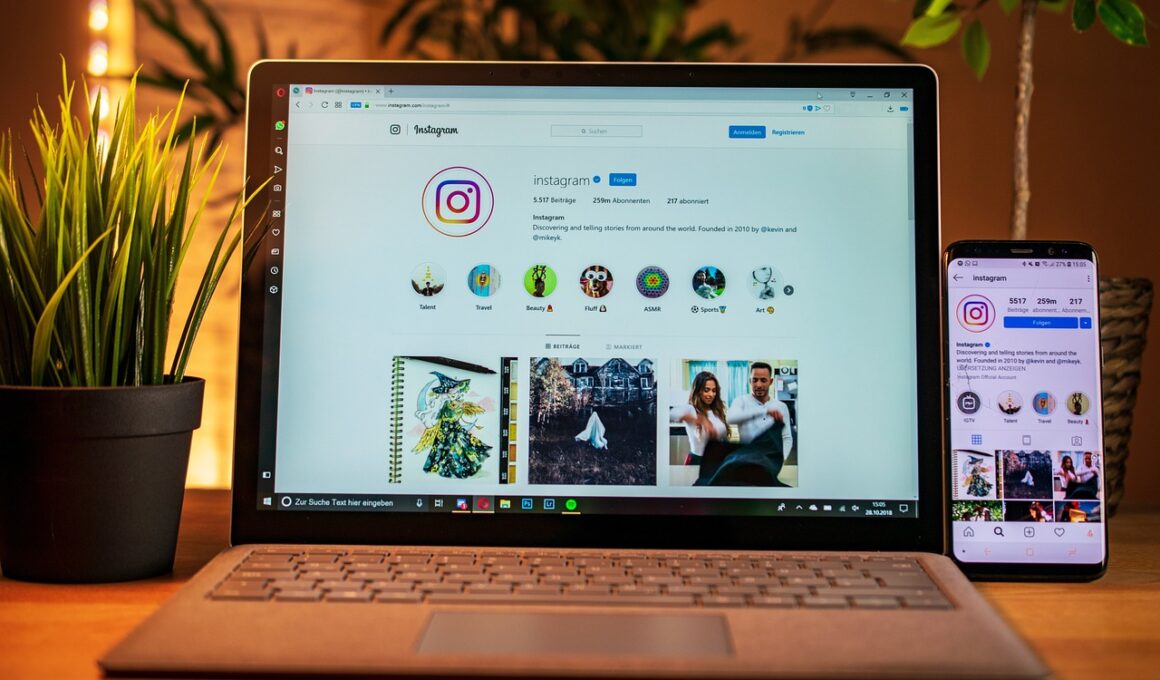Making Instagram Accessible for Different Disability Groups
Instagram has become a significant platform for communication, creativity, and marketing, yet accessibility remains a crucial concern. Individuals with disabilities face various challenges while navigating this popular social media application. To solve this issue, Instagram has evaluated ways to enhance accessibility for everyone. One way to improve accessibility involves incorporating dedicated features for users with diverse needs. This includes improved text alternatives for images, allowing screen readers to convey meaningful content. Additionally, implementing AI to automatically generate descriptive captions can help users with visual impairments. Another strategy is to utilize visual contrast to ensure that all users, especially those with visual impairments, can distinguish between different elements of the app. Additionally, adaptable UIs can offer customized experiences catering to users’ unique needs, thereby facilitating seamless engagement. Another consideration is regular user feedback collection, utilizing input from users with disabilities to help inform future enhancements. This article aims to suggest practical approaches that Instagram can adopt to enhance accessibility for disabled individuals as the platform grows. Creating an inclusive environment for everyone results in a richer user experience and fosters a sense of belonging and community.
Ensuring captions are available on videos is one of Instagram’s most significant accessibility enhancements. Many users rely on captions, not only to understand the content but also to engage with it empathy. Therefore, Instagram can significantly boost interaction by offering accurate captioning services. This helps users who are deaf or hard of hearing experience the content fully. Users could have the ability to customize the appearance of captions, choosing from various colors and fonts according to their aesthetic and readability preferences. Furthermore, Instagram can implement a feature that allows video creators to upload their captions directly, ensuring that the captions are synchronized with the audio effectively. Collaboration with sign language interpreters could also enhance the interaction for the deaf community. Encouraging content creators to provide captions can lead to more informed and engaged audiences. Educating creators about the necessity of accessibility and how it positively impacts their reach can encourage participation. Creating campaigns highlighting the importance of accessibility not only promotes awareness but also fosters a welcoming environment for all users. Consequently, designers will find ways to streamline the caption integration seamlessly into users’ feeds while enhancing overall engagement.
Using Alternative Text Effectively
Alternative text (alt text) serves as an essential feature for visually impaired users on Instagram. Content creators must learn to use this feature effectively, ensuring that images are accompanied by descriptive text. However, many users lack an understanding of how to write effective alt text. By offering users workshops and educational resources, Instagram can help foster a culture of accessibility among its users. For instance, tips on writing alt text could be included in editing tools, guiding users to create meaningful descriptions that convey the image context. This could enhance the overall user experience and inclusivity within the platform. Additionally, Instagram can implement guidelines and examples that demonstrate how to write effective alt text. Encouragement from the platform to take advantage of this feature will inspire more users to participate. Furthermore, offering a community feature where users can share their alt text experiences could promote best practices among creators. This type of collaborative mindset will help users achieve more engaging content. The ultimate goal is to create a community where alt text is considered an essential component of every post, enriching the experience for all users, regardless of their abilities.
Instagram could enhance its engagement by prioritizing the use of sign language for tutorials and live videos. Providing specialized content for the deaf community will promote inclusivity and broaden the reach of various creators. Content creators can collaborate directly with sign language interpreters, ensuring that information is accessible. Displaying the interpreter within the video would deliver clear communication to an audience that relies on these resources. Engaging users from such communities to participate in the content creation process assists in making social media a platform where everyone’s voice is heard. Promoting sign language content can also help normalize communication methods that may otherwise be overlooked. Encouraging creators to think of innovative ways to include sign language in their posts will further challenge the norm of traditional content creation. Moreover, partnerships with organizations that support the deaf community could enhance awareness and provide free resources for all users, ensuring continual learning and growth. Consequently, it provides a more inclusive platform where users can learn, connect, and thrive without limitations imposed by communication barriers. Instagram becomes a hub of varied perspectives, enriching the lives of all users while developing inclusive practices.
Improving Color Contrast and Visual Accessibility
Color contrast plays a crucial role in ensuring that text is legible for individuals with visual impairments. Instagram should assess its color palettes to ensure that every element is easily distinguishable. For users with low vision, implementing adjustable color settings can personalize their experience further. This could mean giving users the option to select high contrast options or customize colors to enhance visibility. Furthermore, adding a feature that allows users to toggle on a color-blind mode would benefit a significant portion of the audience. Such features can empower users to engage more deeply with content and have fluid conversations. Encouraging Instagram developers to prioritize visual accessibility during design can yield long-lasting benefits for all users. Additionally, incorporating visual sensitivity tests prior to rolling out new design elements can ensure that changes meet accessibility standards. Instagram can conduct usability testing with diverse users to understand visually impaired consumers’ preferences better. As a result, it will create a process that’s as inclusive as possible, making sure that every new update is accessible and visually appealing. Empowering greater accessibility ensures a more enriching experience across the platform, fostering inclusion for all users.
User experience is paramount when it comes to the accessibility of any platform, including Instagram. Therefore, conducting regular audits to identify accessibility challenges faced by disabled users is crucial. These audits can help the platform identify areas needing attention. Engaging with users who have disabilities can foster an open dialogue, allowing the platform to evolve based on real feedback. Moreover, creating a reporting feature specifically for accessibility concerns encourages users to voice their challenges. Once identified, it’s essential for Instagram to address these issues in an efficient timeframe. Hosting community forums focused on accessibility matters can also provide an avenue for feedback, creating a culture of user engagement. Collaborating with organizations focused on disability advocacy can yield meaningful insights to inform updates effectively. Additionally, incorporating accessibility into Instagram’s branding initiatives can signal to users that inclusivity is a priority for the platform. This transparency instills trust and creates a sense of belonging among users. Promoting these changes through user stories would further highlight accessibility enhancements and inspire other social media platforms to follow suit, unlocking more opportunities for dialogue and interaction. Enhancing accessibility on Instagram solidifies its position as an inclusive space.
The Role of Community and User Feedback
Instagram can harness the power of its community by amplifying users’ voices regarding accessibility. Listening to the feedback from users with disabilities will lead to meaningful improvements that resonate across demographics. This includes promoting user-driven initiatives where participants can share their ideas for enhancing accessibility. By doing so, Instagram can foster a culture of co-creation, where improvements are aligned with users’ needs. Regular workshops and online forums can address accessibility challenges encountered by users, while also sharing solutions and success stories. Celebrating users who actively contribute to making the platform more inclusive can encourage others to participate, facilitating a positive cycle of growth. Appropriately recognizing these contributors can come in the form of credits, shoutouts, or rewards. The platform can also use social media influencers to spread the word accurately. Collaborating with influencers who advocate for disability rights or awareness will further establish credibility surrounding accessibility initiatives. Instagram can catalyze a community-driven approach by harnessing user feedback, motivating users to work collaboratively toward creating impactful change. By prioritizing community needs, Instagram will evolve and serve as a robust platform that caters to diverse user needs.
Finally, as Instagram continues to adapt to the ever-changing digital landscape, it becomes increasingly vital that social media platforms prioritize accessibility. The company must remain committed to refining features that cater to various disabilities, forging a new pathway toward inclusion. Stakeholders on Instagram hold individual accountability in promoting an accessible space, positively impacting the lives of users with disabilities. Continuous investment in training for developers and designers on best practices for accessibility can increase overall awareness of these needs. Companies should leverage partnerships with accessibility experts to gain insights that can shape Instagram’s development agendas. Additionally, gaining feedback from organizations supporting persons with disabilities ensures that implemented solutions meet the intended needs. Furthermore, promoting transparency by documenting accessibility changes establishes trust with the community. By actively showcasing success stories, Instagram can create a culture of appreciation for inclusion. Ultimately, the shared responsibility for accessibility holds true for everyone. When platforms champion accessibility proactively, they create a welcoming environment for individuals of all abilities. Instagram can lead change within social media while demonstrating its commitment to enhancing the experiences of every user who engages with the platform.


